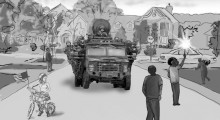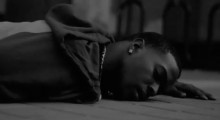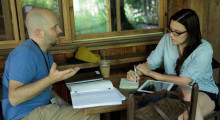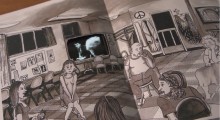Authors — Scott Macaulay
-
Five Questions for Writer/Director Scott Blake about his Kickstarter Project, Victory

25 New Face filmmaker Scott Blake is currently raising funds on Kickstarter for an ambitious “urban insurgency” short film, Victory. Below, he discusses inspiration ranging from Michael Mann to Joseph Conrad, why he cast Kentucker Audley and why he’s making another short. Please visit his Kickstarter page to learn more. Filmmaker: First, let’s start with Surveyor and the 25 New Faces. You were one of our real discoveries, as your film hadn’t played many festivals and you hadn’t received much notice for it. What has happened after being selected for the 25, and how did that path lead to this […]
by Scott Macaulay on Nov 30, 2014 -
Filmmakers Launch #BlackoutBlackFriday Day of Activism, Events and Retail Boycott

In the wake of the decision not to prosecute Ferguson police officer Darren Wilson for the killing of Michael Brown, Fruitvale Station director Ryan Coogler has joined with Selma director and AFFRM founder Ava DuVernay to launch Blackout for Human Rights, “a network committed to ending human rights violations at the hands of public servants.” The group, which includes a number of directors, actors and others, builds on this week’s nationwide protests with events and actions, including today’s #BlackoutBlackFriday. From the group’s Tumblr: About #BlackoutBlackFriday: We ask those who stand with Ferguson, victims of police brutality and us to refrain […]
by Scott Macaulay on Nov 28, 2014 -
Hope for Film Author Ted Hope on Life, Independent Film and Systems Reboots

Ted Hope — producer, Good Machine co-founder, and now CEO of Fandor — is no tongue-tied wallflower in the independent film community. Indeed, his passionate commentary, counsel and editorializing on topics ranging from net neutrality to making better films to a “systems reboot” of the independent film economy seem to be everywhere these days. But while his website, Twitter account and frequent speeches at industry events may make it seem that his opinions have been enabled — or at least turbo-charged — by this current social media age, he has, in fact, been lobbing list-driven rhetorical broadsides for years. (Don’t […]
by Scott Macaulay on Nov 24, 2014 -
The Economy of Web Series and Five Questions for This Is Not a Conspiracy Theory Director Kirby Ferguson

Kirby Ferguson’s four-part web series, Everything is a Remix, was a brilliant blend of form, content and delivery system. A discussion of not just the legal issues surrounding fair use and appropriated content but also the nature of creativity itself, Ferguson’s work scored hundreds of thousands of views, launched a TED talk and established this savvy director at the forefront of the DIY web content creation business. With his new recently launched series, This is Not a Conspiracy Theory, he is aiming to make that web content creation business more of a, well, business by switching from free to a […]
by Scott Macaulay on Nov 24, 2014 -
Sundance Announces Creative Producing Lab & Fellowship Call for Entries

Over the years Sundance has steadily increased its support for young independent film producers, with the more recently created Creative Producing Lab & Fellowship as loved by producers as the Screenwriting and Directing Labs are loved by writers and directors. (Don’t believe me? Well, here’s producer Gabrielle Nadiq on the program in 2013: “The Sundance Creative Producing Lab changed my life… I have never been a part of a program that was so nurturing, generous, uplifting, and reinvigorating. Nor have I had an experience that so completely broke me down and built me back up as a filmmaker.”) The program […]
by Scott Macaulay on Nov 21, 2014 -
David Lynch and Patti Smith Talk Blue Velvet, Twin Peaks and More on the BBC

David Lynch can be a tough interview — check out my attempt back in 2001. Patti Smith does a bit better in this joint interview on the BBC2 Newnight’s Encounters series. They both discuss their memories first hearing the song “Blue Velvet,” and Smith’s reflexive lyricism brings out something allied in Lynch. Check it out.
by Scott Macaulay on Nov 21, 2014 -
Five Questions for Sam Green About His Live Documentary, The Measure of All Things

The biggest, the smallest, the most, the more-times-than-anyone-else — filmmaker Sam Green has revisited a common childhood fascination, The Guiness Book of World Records, for his latest “live documentary,” The Measure of All Things, receiving its New York premiere at The Kitchen this week. It’s Green’s third work combining film, music and his own on-stage narration — a hybrid film/theater form that’s proved surprisingly popular in performing arts venues around the world. Indeed, when so many filmmakers are trying to figure out a “new model” for their work, Green has turned himself into a touring artist, finding new, less jaded […]
by Scott Macaulay on Nov 20, 2014 -
Five Questions for Ann Marie Fleming and Sandra Oh About Their Indiegogo Project, Window Horses

Currently raising funds on Indiegogo is an ambitious animated feature by filmmaker Ann Marie Fleming, Window Horses. With a lead character voiced by Sandra Oh, the film uses the medium of poetry to explore ideas of cross cultural exchange. From their Indiegogo page: In this coming-of-age story, Rosie Ming, a young Canadian poet, is invited to perform at a Poetry Festival in Shiraz, Iran, but she’d rather be in Paris. She lives at home with her over-protective Chinese grandparents and has never been anywhere by herself. Once in Iran, she finds herself in the company of poets and Persians, all […]
by Scott Macaulay on Nov 20, 2014 -
Kubrick Sees Red: A Supercut On the Director’s Love of the Color

Blood can’t be any other color, but there are plenty of things — like spacesuits and bathroom walls — that can. In this punchy, to-the-point supercut, Rishi Kaneria draws from 2001, Full Metal Jacket, The Shining, Barry Lyndon and other Kubrick films to make a case for the director’s love of the crimson.
by Scott Macaulay on Nov 19, 2014 -
Encounter Groups, Ghost Stories and Rapid Prototyping at the Seventh POV Hackathon

“There are a lot of things I like about your project, but the effects on the videos are not one of them.” “How is this different from Second Life?” “Your video — it’s kind of boring.” Participating in a hackathon, like POV’s which wrapped Sunday, Nov. 9, means opening yourself up to blunt feedback. Forty-eight hours of project development and rapid prototyping, POV’s hackathons pair documentary filmmakers with mentors and programmers and task them with extending non-fiction storytelling beyond the cinema (or television) walls. This month’s event — POV’s seventh — concluded with the five selected teams presenting their projects […]
by Scott Macaulay on Nov 18, 2014
